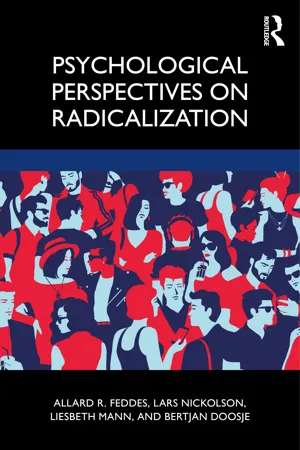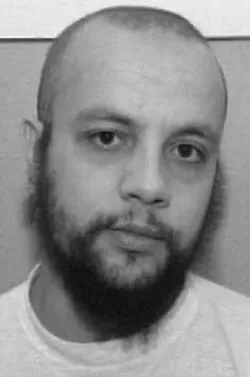Goals
•Present two concrete examples of members from two different radical groups.
•Outline why radicalization is an important topic to study.
•Give a brief historical overview of terrorism.
•Present the scope and outline of this book.
These are just two examples of people deciding to commit acts of terror by murdering other people. Why? What could have been their motives? What did they aim to achieve? In this book, we aim to provide answers to these questions by drawing on scientific theories and empirical research on radicalization and terrorism. In doing so, we mostly (but not exclusively) draw on literature from a psychological perspective. We will find out that there is no simple checklist to determine why, when, and how a person might execute a terror attack. Still, we argue it is possible to establish certain factors that increase the likelihood that a person might believe violence is a valid and necessary tool to achieve changes in a society. In Boxes 1.1 and 1.2, we describe the lives of Mohammed Bouyeri and Anders Breivik, respectively. In subsequent chapters, we will draw on these examples to illustrate certain issues or arguments we present.
Box 1.1 Mohammed Bouyeri
•Born on March 8, 1978.
•Assassinated Dutch filmmaker Theo van Gogh on November 2, 2004, in Amsterdam, The Netherlands.
•Convicted of murder on July 26, 2005, Bouyeri received a life sentence without a chance of parole.
On March 8, 1978, Mohammed Bouyeri is born in (the Eastern part of) Amsterdam, The Netherlands. When he turns 7, Bouyeri moves to an area in the West of Amsterdam (Slotervaart/Overtoomse Veld). Aged 12, Bouyeri goes to second highest level of secondary school (Havo) at the Mondriaan Lyceum. “He was timid and attentive,” according to a teacher at this school (quoted in 2005 in NRC Handelsblad). “He wanted to make a career. He had to work hard to receive his degree.” In 1997, Bouyeri goes to the college Hogeschool Holland in Diemen near Amsterdam. He spends five years at this college, pursuing several majors. He does not complete any of them.
In 2000, Bouyeri is involved in a violent incident for the first time. At the campus bar of Hogeschool Holland, he and his friends challenge Dutch students, and there is a fight. In 2001, he and another young Dutch person with a Moroccan background start a fight over Bouyeri’s younger sister. When the police arrive, Bouyeri shows his knife and tries to cut an agent. Finally, he throws the knife at the head of the agent. For this violent incident, Bouyeri serves a prison sentence.
He is released at the end of 2001. This is a period in which his mother dies and the attacks on the Twin Towers take place. Bouyeri starts at the Higher College Amsterdam with the major social pedagogical caregiving. He also becomes active at the local youth center, Eigenwijks, helping youth in his neighborhood, Slotervaart/Overtoomse Veld.
In 2002, he starts taking action to try to create his own place for the youth at the high school Mondriaan Lyceum where they can do their homework and relax. However, his plan is not accepted by the authorities. According to Wim Knol, owner of the youth center Eigenwijks, Bouyeri is disappointed. He quotes Bouyeri: “I have had enough of the institutions,” and “We Moroccan people are good enough to be used as a contact person, as long as we do not take initiatives.”
His appearance changes: he starts wearing a beard and traditional clothing, including a djellaba (long, loose-fitting robe with long sleeves and often a kind of hood; it is worn down to the ankles and usually has a neutral color). He decides to stop with his college and education at the end of 2002 (Figure 1.1).
Figure 1.1 Mohammed Bouyeri in 2004. (From https://en.wikipedia.org/wiki/Mohammed_Bouyeri.)
After the summer of 2003, Bouyeri changes dramatically. He starts religious arguments with people from the local youth center, Eigenwijks (he does not want to serve alcohol, and he wants separate rooms for men and women). From then on, people from Eigenwijks start to lose sight of Bouyeri. He also no longer wants to interact with the Moroccan youth in his neighborhood. He starts to dislike their hanging around and their use of soft drugs and alcohol. In addition, he distances himself from his family. At first, he wants to convert his family to his notion of the true Islam. However, when he fails to do so, there seems to be more distance between him and his family. Finally, he also stops going to the local Moroccan mosque, El Ouma, where his father prays every Friday. Apparently, he tells the Imam: “You do not tell the truth.” He now goes to the Salafi mosque, El Tawheed, in a nearby area, Oud-West. He interacts with a Syrian man named Abu Khaled, a Jihadi advocate, who teaches him more anti-Western attitudes.
Bouyeri starts articulating his ideas on paper and in discussions. For example, he is quoted as disliking national sentiments (both Moroccan and Dutch): “The strongest bond is thus the religious bond. This bond is stronger than the stupid nationalistic and chauvinistic sentiments, as well as relations based on blood ancestry” (quoted in Bahara, 2014). His dislike for the Dutch legal system is illustrated by this quote: “Authorities of ‘kuffaar’ (infidels) over Muslims are not valid.” Finally, he writes to the youth: “Liberate yourself! Get out of that coffee shop, get out that bar, get out of that corner. Join the caravan of Martyrs. Rise up from your deep sleep, rise up and shake the dust of humiliation off of you. Rise up and listen to the call HAJJA AL JIHAD” (quoted in Bahara, 2014).
On November 2, 2004, Bouyeri shoots the Dutch filmmaker and Islam critic Theo van Gogh, who is cycling on the streets of Amsterdam. Van Gogh falls from his bicycle and pleads: “Mercy. Mercy. We can still talk about it.” But Bouyeri shoots again, this time killing him, and leaves a farewell note, as he expects to die in the following moments during his arrest. But he is arrested alive in a park nearby.
On the second and final day of his trial, Bouyeri says, “I have let myself be led by the rule that commands me to chop off the head of everyone that insults Allah and the prophet.” And to the mother of Van Gogh, he says: “I must admit that I do not empathize. I do not feel your pain. I cannot. I do not know what it is like to lose a child that you have brought to the world with so much pain and tears. This is partly due to the fact that I am not a woman. And partly I cannot empathize with you because you are an infidel.”
Mohammed Bouyeri is convicted of murder on July 26, 2005. He receives a life sentence without a chance of parole.
In 2006, Bouyeri has to appear in court again, this time for his involvement in the Hofstad group, the group of radicalized/extremist people around him. The court finds him guilty of being the leader of this group. This does not translate into a longer sentence, as he has already received the maximum (i.e., life) sentence.
Sources used in this box:
Bahara, H. (2014). “Rijst op uit jullie slaap” [‘Rise from your sleep’]. De Groene Amsterdammer, October 22. https://www.groene.nl/artikel/rijst-op-uit-jullie-slaap.
Buijs, F. J., Demant, F., & Hamdy, A. (2006). Warriors from own soil: Radical and democratic Muslims in The Netherlands. Amsterdam: Amsterdam University Press.
Wikipedia entry on Mohammed Bouyeri. https://en.wikipedia.org/wiki/Mohammed_Bouyeri.
Box 1.2 Anders (Behring) Breivik
•Born on February 13, 1979.
•On July 22, 2011, Breivik killed eight people with a car bomb in Oslo, Norway. A couple of hours later, with guns and dressed as a policeman, he murdered 69 youngsters associated with the youth organisation of the Labour Party, on the small island Utøya, 50 kilometers from Oslo.
•Convicted of murder on August 24, 2012, Breivik received the maximum prison sentence in Norway, which is 21 years, with a minimum of 10 years.
Anders Behring Breivik is born in Oslo, Norway, on February 13, 1979. His parents divorce when Breivik is one year old, and he lives with his mother in O...

